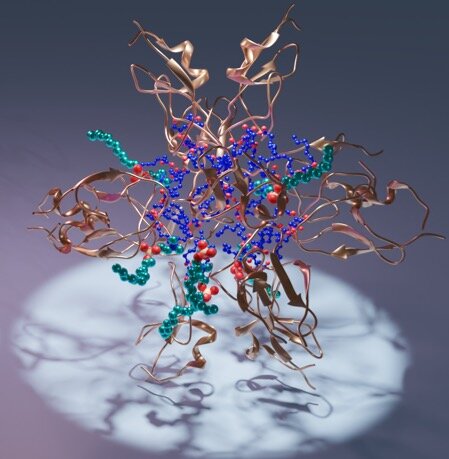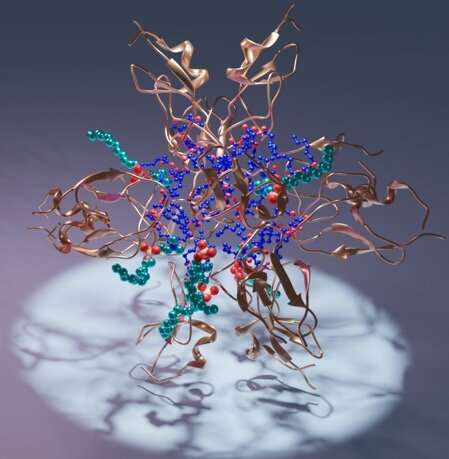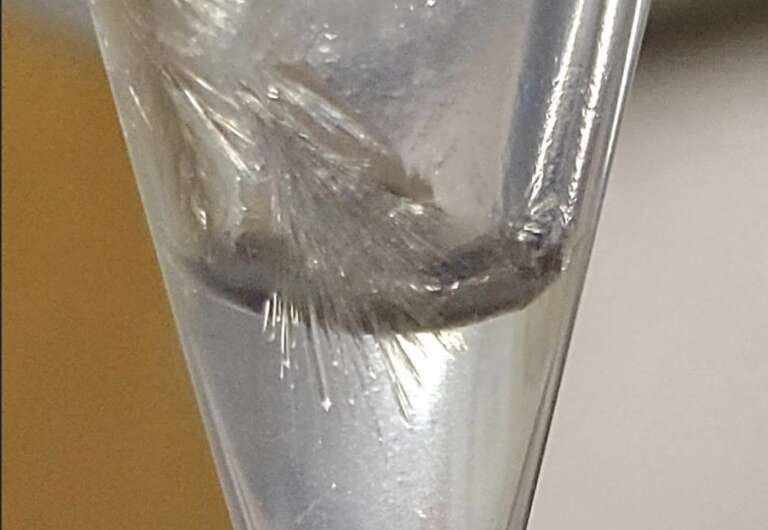

In a major advance for rational drug design, a Texas A&M AgriLife team has described several protein structures of a crucial player in cellular processes. The advance could bring new ideas for treatments of diseases such as Alzheimer’s, AIDS, cancer and others.
Specifically, the work describes the C1 domain of protein kinase C, PKC, which helps regulate the protein’s activity in organisms. In the structures, the C1 domain wraps around different molecules of intense therapeutic interest, providing the first reliable, atomic-resolution guide for designing drug candidates.
Published May 16 in Nature Communications, the research was directed by Tatyana Igumenova, Ph.D., associate professor in the Department of Biochemistry and Biophysics in the Texas A&M College of Agriculture and Life Sciences. The project’s primary author is Sachin Katti, Ph.D., a postdoctoral fellow working with Igumenova.
The study involved a collaboration with Inna Krieger, Ph.D., research assistant professor, and James Sacchettini, Ph.D., professor, both in the Department of Biochemistry and Biophysics.
One of the most sought-after protein structures
A healthy cell responds to chemical signals in precise, intricate ways. Receiving chemical inputs from the cell’s environment and forwarding them to the central control systems within the cell nucleus is the task of specialized proteins such as PKC.
Improper PKC activity shows up in many human diseases. As a result, there is much interest in finding ways to fine-tune PKC activity with drugs. The design of such drugs will offer new approaches for treating Alzheimer’s disease, AIDS, cancer and more.
“Protein kinase C is one of the most intensely studied proteins in cell biology and pharmacology,” Igumenova said. “A major hurdle has been the lack of precise structural information to guide drug design efforts.”
One complication for drug design is that the PKC family has 11 members. Different PKC family members can have opposite physiological effects, so a successful drug candidate must be selective about which PKC it targets.
To do that, drug candidates must fit a target PKC like a key to a lock. But determining the 3D structure of a PKC “on-switch”—the C1 domain—bound to PKC activators has not been easy.
Protein structures are typically solved using X-ray crystallography. The technique involves using X-rays to determine the position of atoms in a crystal. For this method, researchers need to create conditions where the protein of interest crystallizes. Yet intense efforts in many research labs over the past three decades failed to yield crystals of C1 domains bound to relevant ligands. Because of this lack of progress, multiple researchers pronounced the task impossible, Igumenova said.

Solving a 30-year problem
Accepting the problem as challenging, Katti and Igumenova decided instead to study the molecules in solution using nuclear magnetic resonance, NMR, spectroscopy. This involved finding the right components to mimic cell membranes, where the C1 domain would encounter ligands.
“Then, one fine day, Sachin discovered crystals forming in an old NMR tube,” Igumenova said. “I give all the credit to Sachin, who basically said, ‘I’m going to go and test them and see if they are actually the protein.’ And he was right. It gave us confidence that crystallization is possible.”
In turn, Katti gives credence to the insights obtained from NMR, and a bit of luck.
“I think that’s the beauty of doing research where you have to use multiple approaches,” he said. “You never know when one approach is going to be useful for doing something with other approaches.”
Insights from NMR and X-ray crystallography
The new protein structures, along with the team’s NMR results, have already yielded interesting information. One long-standing mystery has been how C1 domains can accommodate ligands that have very different chemical structures, Igumenova said.
“Our previous NMR work indicated that the loops of the C1 domain that bind ligands are very dynamic,” Igumenova said. “This C1 domain is like a PAC-man. It binds the membrane, and then it searches for a ligand. Once it finds the ligand, it latches on.”
In addition, the structure shows that the ligand-binding groove has a “water-loving,” or hydrophilic, surface at the bottom, and “water-repelling,” or hydrophobic, surface at the top.
“If you think about a lipid molecule, the head group is hydrophilic and the tail is hydrophobic,” Igumenova said. “So, when C1 domains bind lipid ligands, the patterns match.”
The team’s results include the structure of a C1 domain bound to its natural ligand, diacylglycerol. In addition, the team describes several other structures of C1 that include different compounds of pharmacological interest.
The work also provides a method for testing different drug candidates, Katti said.
“If you want to study fish, you want to study them in water,” Katti said. “Now we know how to create a membrane-like environment where these very hydrophobic compounds can be tested for C1 binding.”
Next, Katti and Igumenova plan to explore C1 domains from other PKC family members.
“It’s important for us to focus on C1 domains because they have inherent differences that can be exploited to achieve selectivity,” Igumenova said. “What we are finding now is that not all C1 domains are created equal.”
Findings reveal new mechanism of activation for ALK
Sachin S. Katti et al, Structural anatomy of Protein Kinase C C1 domain interactions with diacylglycerol and other agonists, Nature Communications (2022). DOI: 10.1038/s41467-022-30389-2
Texas A&M University
Citation:
New protein structures to aid rational drug design (2022, May 17)
retrieved 17 May 2022
from https://phys.org/news/2022-05-protein-aid-rational-drug.html
This document is subject to copyright. Apart from any fair dealing for the purpose of private study or research, no
part may be reproduced without the written permission. The content is provided for information purposes only.